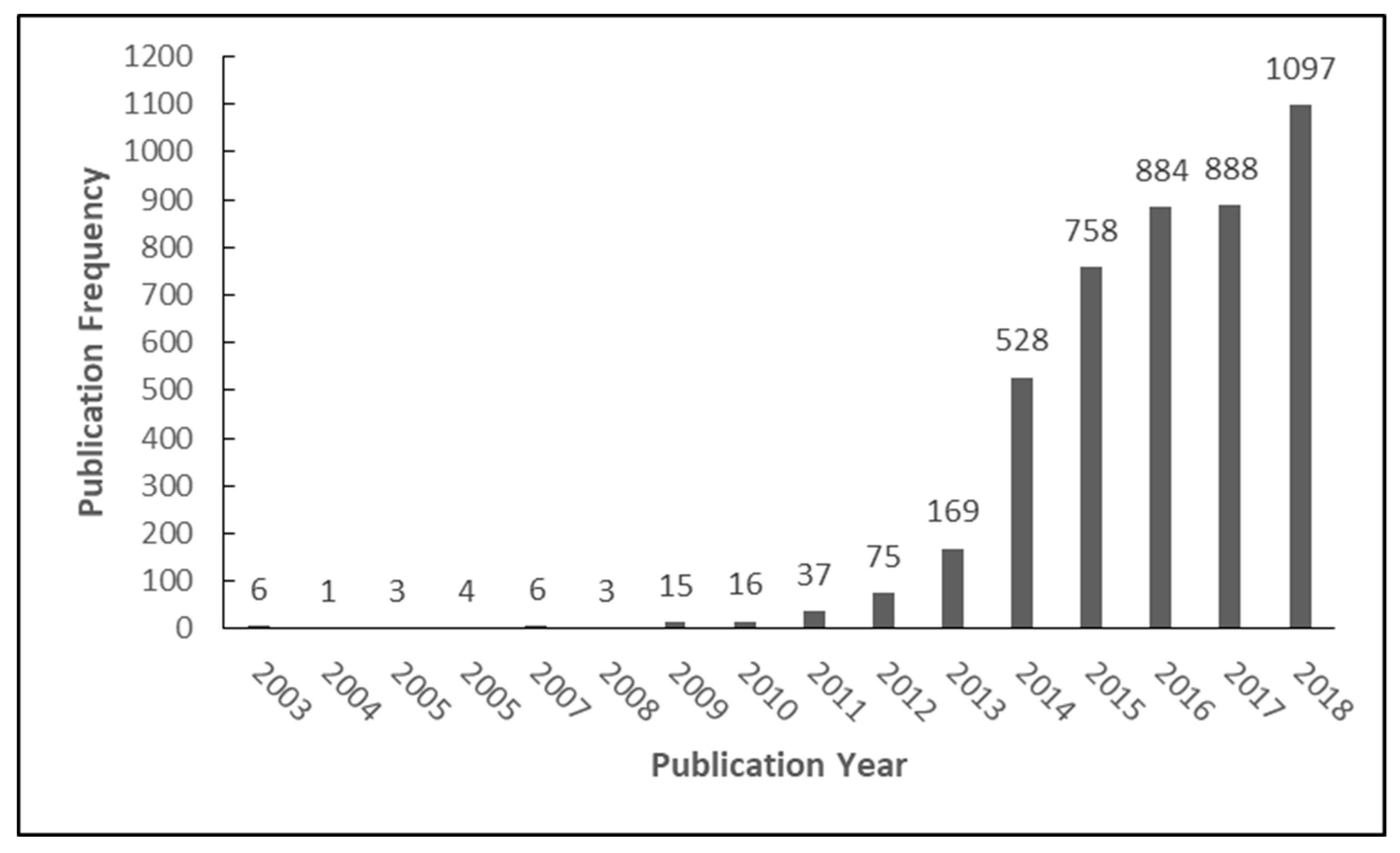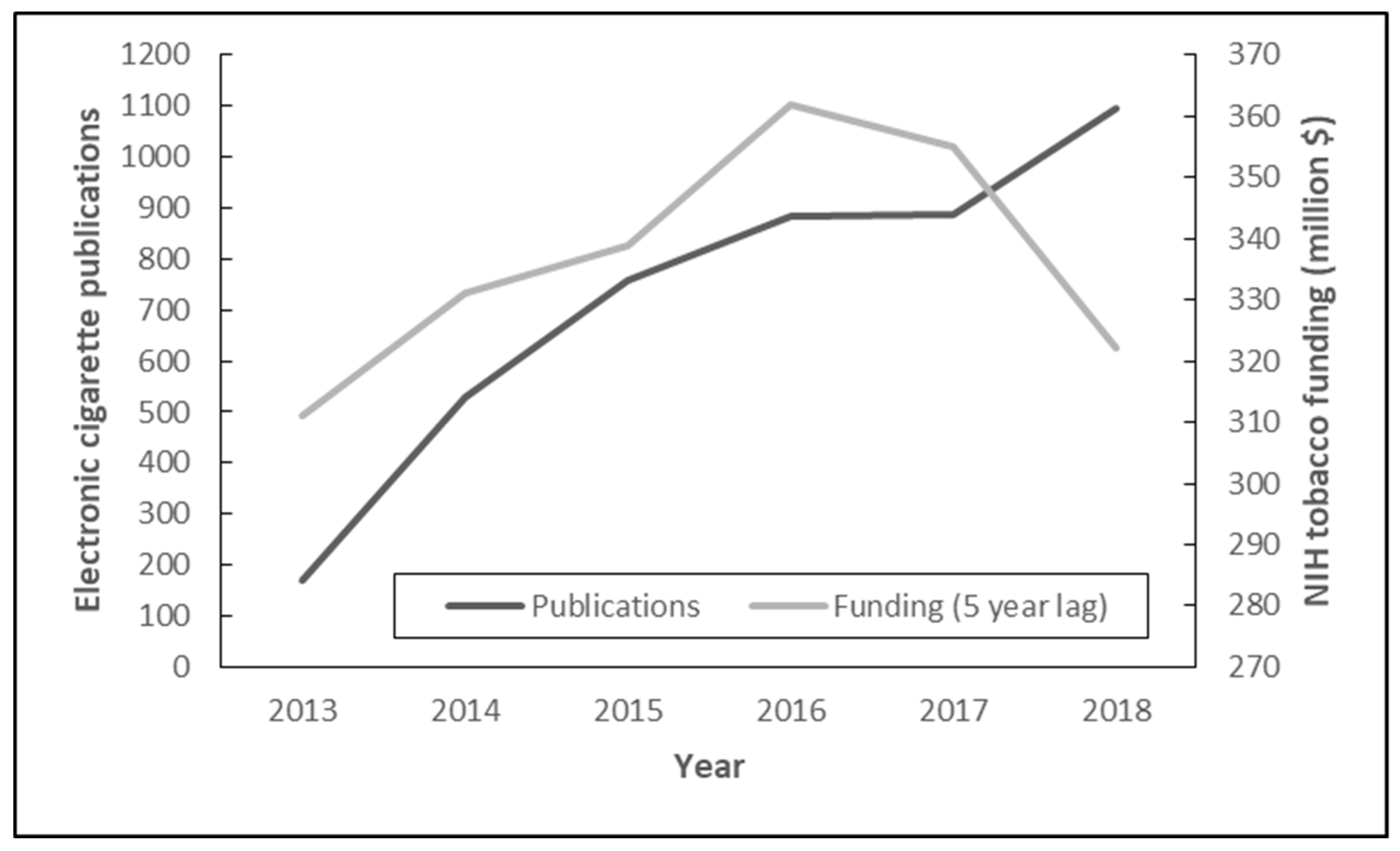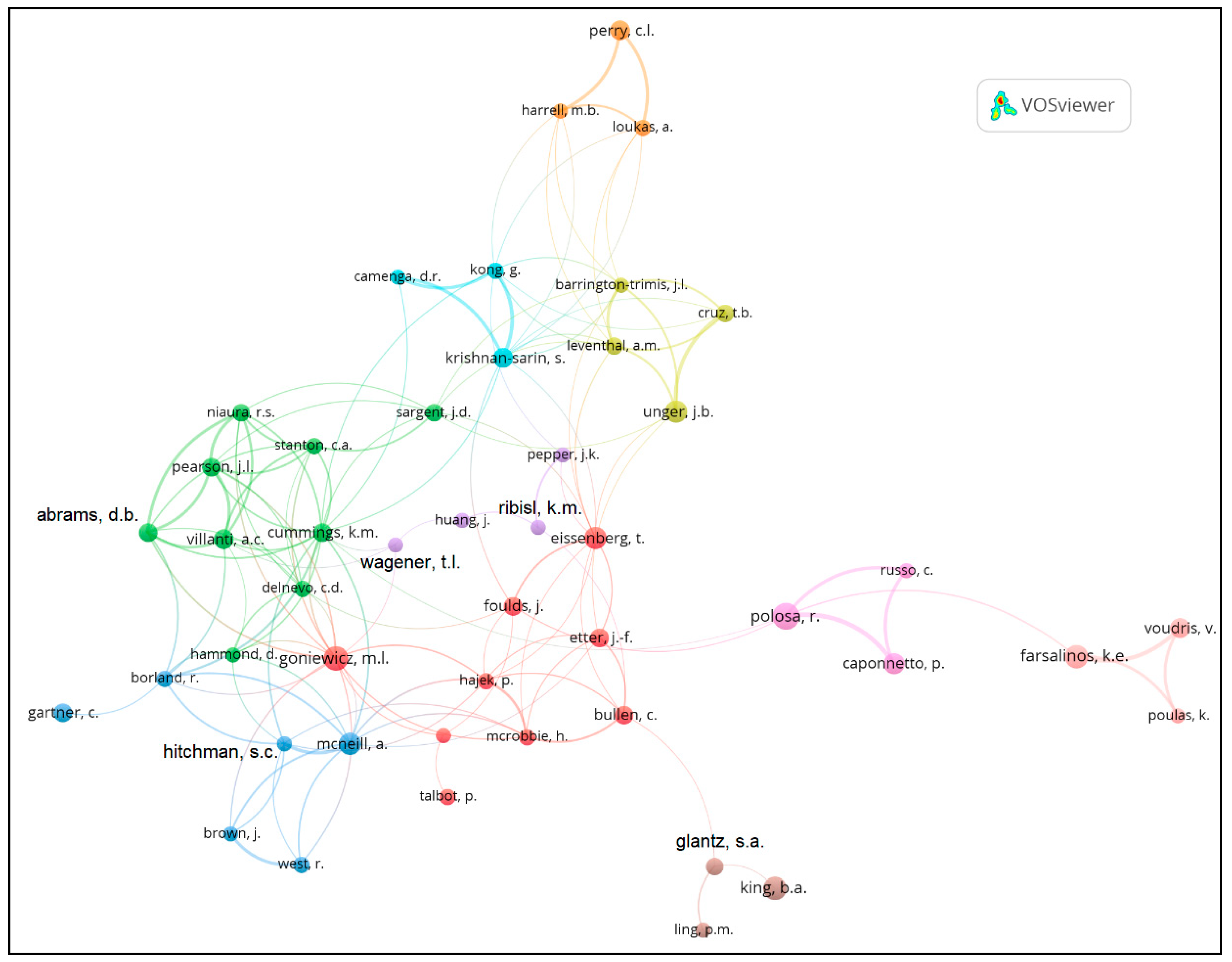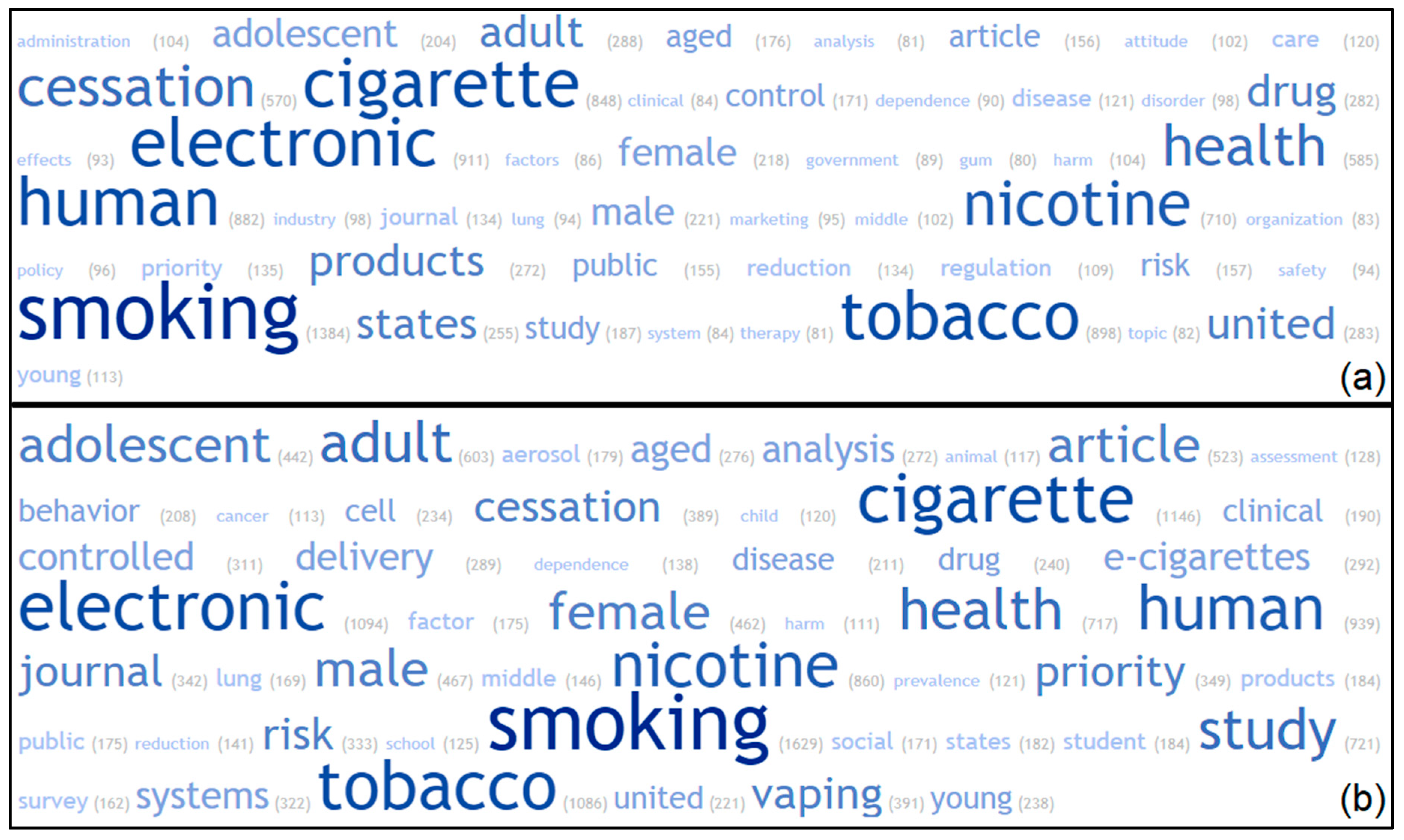Bibliometric Analysis of Electronic Cigarette Publications: 2003–2018
Abstract
1. Introduction
2. Materials and Methods
3. Results
4. Discussion
5. Conclusions
Author Contributions
Funding
Conflicts of Interest
References
- Historical Timeline of Electronic Cigarettes. Available online: http://www.casaa.org/historical-timeline-of-electronic-cigarettes/ (accessed on 22 January 2019).
- Giovenco, D.P.; Hammond, D.; Corey, C.G.; Ambrose, B.K.; Delnevo, C.D. E-Cigarette market trends in traditional U.S. retail channels, 2012–2013. Nicotine Tob. Res. 2015, 17, 1279–1283. [Google Scholar] [CrossRef] [PubMed]
- Wang, T.W.; Gentzke, A.; Sharapova, S.; Cullen, K.A.; Ambrose, B.K.; Jamal, A. Tobacco product use among middle and high school students—United states, 2011–2017. Morb. Mortal. Wkly. Rep. 2018, 67, 629–633. [Google Scholar] [CrossRef] [PubMed]
- McMillen, R.C.; Gottlieb, M.A.; Whitmore Shaefer, R.M.; Winickoff, J.P.; Klein, J.D. Trends in electronic cigarette use among U.S. adults: Use is increasing in both smokers and nonsmokers. Nicotine Tob. Res. 2015, 17, 1195–1202. [Google Scholar] [CrossRef] [PubMed]
- U.S. Department of Health and Human Services. E-Cigarette Use among Youth and Young Adults. A Report of the Surgeon General; U.S. Department of Health and Human Services, Centers for Disease Control and Prevention, National Center for Chronic Disease Prevention and Health Promotion, Office on Smoking and Health: Rockville, MD, USA, 2016.
- World Health Organization. Evaluation of the Impact of WHO Publications; WHO Evaluation Office: Ottawa, Canada, 2016. [Google Scholar]
- Weible, C.M.; Sabatier, P.A.; McQueen, K. Themes and Variations: Taking Stock of the Advocacy Coalition Framework. Policy Stud. J. 2009, 37, 121–140. [Google Scholar] [CrossRef]
- Smith, K. Beyond Evidence Based Policy in Public Health: The Interplay of Ideas; Palgrave Macmillan: Basingstoke, UK, 2013; pp. 1–251. [Google Scholar]
- Koskinen, J.; Isohanni, M.; Paajala, H.; Jaaskelainen, E.; Nieminen, P.; Koponen, H.; Tienari, P.; Miettunen, J. How to use bibliometric methods in evaluation of scientific research? An example from Finnish schizophrenia research. Nord. J. Psychiatry 2008, 62, 136–143. [Google Scholar] [CrossRef] [PubMed]
- Sweileh, W.M.; Al-Jabi, S.W.; AbuTaha, A.S.; Zyoud, S.H.; Anayah, F.M.A.; Sawalha, A.F. Bibliometric analysis of worldwide scientific literature in mobile-health: 2006–2016. BMC Med. Inform. Decis. Mak. 2017, 17. [Google Scholar] [CrossRef]
- Sweileh, W.M.; Al-Jabi, S.; Zyoud, S.H.; Sawalha, A.F. Bibliometric analysis of literature in pharmacy education: 2000–2016. Int. J. Pharm. Pract. 2018, 26, 541–549. [Google Scholar] [CrossRef]
- Khan, M.B.S.; Ullah, W.; Riaz, I.B.; Bhulani, N.; Manning, W.J.; Tridandapani, S.; Khosa, F. Top 100 cited articles in cardiovascular magnetic resonance: A bibliometric analysis. J. Cardiovasc. Magn. Reson. 2016, 18, 87. [Google Scholar] [CrossRef]
- Chapman, S.; Derrick, G. Bibliographic analysis of papers and authors published in Tobacco Control 1998–September 2011. Tob. Control 2012, 21, 198–201. [Google Scholar] [CrossRef]
- Cohen, J.E.; Chaiton, M.O.; Planinac, L.C. Taking stock a bibliometric analysis of the focus of tobacco research from the 1980s to the 2000s. Am. J. Prev. Med. 2010, 39, 352–356. [Google Scholar] [CrossRef]
- Li, D.; Okamoto, J.; Liu, H.; Leischow, S. A bibliometric analysis on tobacco regulation investigators. BioData Min. 2015, 8. [Google Scholar] [CrossRef]
- Unutmaz Durmuşoğlu, Z.D.; Kocabey Çiftçi, P. An analysis of trends in publications on ‘tobacco control’. Health Educ. J. 2017, 76, 544–556. [Google Scholar] [CrossRef]
- Zyoud, S.H.; Al-Jabi, S.W.; Sweileh, W.M. Worldwide research productivity in the field of electronic cigarette: A bibliometric analysis. BMC Public Health 2014, 14, 667. [Google Scholar] [CrossRef] [PubMed]
- The largest database of peer-reviewed literature-Scopus | Elsevier Solutions. Available online: https://www.elsevier.com/solutions/scopus (accessed on 22 January 2019).
- Schneider, M.; Kane, C.M.; Rainwater, J.; Guerrero, L.; Tong, G.; Desai, S.R.; Trochim, W. Feasibility of common bibliometrics in evaluating translational science. J. Clin. Transl. Sci. 2017, 1, 45–52. [Google Scholar] [CrossRef] [PubMed]
- Culquichicón, C.; Hernández-Pacherres, A.; Labán-Seminario, L.M.; Cardona-Ospina, J.A.; Rodríguez-Morales, A.J. Where are we after 60 years of paragonimiasis research? A bibliometric assessment. Infez. Med. 2017, 25, 142–149. [Google Scholar] [PubMed]
- Physicist Proposes New Way to Rank Scientific Output. Available online: https://phys.org/news/2005-11-physicist-scientific-output.html (accessed on 22 January 2019).
- VOSviewer-Features-Highlights. Available online: http://www.vosviewer.com/features/highlights (accessed on 22 January 2019).
- NIH Categorical Spending-NIH Research Portfolio Online Reporting Tools (RePORT). Available online: https://report.nih.gov/categorical_spending.aspx (accessed on 22 January 2019).
- TagCrowd.com. 2019. Available online: https://ednak.com/tagcrowd/ (accessed on 22 January 2019).
- Benjamin, E.J.; Blaha, M.J.; Chiuve, S.E.; Mary, C.; Das, S.R.; Rajat, D.; de Ferranti, S.D.; James, F.; Myriam, F.; Cathleen, G.; et al. Heart Disease and Stroke Statistics—2017 Update: A Report from the American Heart Association. Circulation 2017, 135, e603. [Google Scholar] [CrossRef] [PubMed]
- Piepoli, M.F.; Hoes, A.W.; Agewall, S.; Albus, C.; Brotons, C.; Catapano, A.L.; Cooney, M.; Corrà, U.; Cosyns, B.; Deaton, C.; et al. 2016 European Guidelines on cardiovascular disease prevention in clinical practiceThe Sixth Joint Task Force of the European Society of Cardiology and Other Societies on Cardiovascular Disease Prevention in Clinical Practice (constituted by representatives of 10 societies and by invited experts) Developed with the special contribution of the European Association for Cardiovascular Prevention & Rehabilitation (EACPR). Eur. Heart J. 2016, 37, 2315–2381. [Google Scholar] [CrossRef] [PubMed]
- Goniewicz, M.L.; Knysak, J.; Gawron, M.; Kosmider, L.; Sobczak, A.; Kurek, J.; Prokopowicz, A.; Jablonska-Czapla, M.; Rosik-Dulewska, C.; Havel, C.; et al. Levels of selected carcinogens and toxicants in vapour from electronic cigarettes. Tob. Control 2014, 23, 133–139. [Google Scholar] [CrossRef]
- Bullen, C.; Howe, C.; Laugesen, M.; McRobbie, H.; Parag, V.; Williman, J.; Walker, N. Electronic cigarettes for smoking cessation: A randomised controlled trial. Lancet 2013, 382, 1629–1637. [Google Scholar] [CrossRef]
- Grana, R.; Benowitz, N.; Glantz, S.A. E-cigarettes: A scientific review. Circulation 2014, 129, 1972–1986. [Google Scholar] [CrossRef]
- Etter, J.; Bullen, C. Electronic cigarette: Users profile, utilization, satisfaction and perceived efficacy. Addiction 2011, 106, 2017–2028. [Google Scholar] [CrossRef] [PubMed]
- Caponnetto, P.; Campagna, D.; Cibella, F.; Morjaria, J.B.; Caruso, M.; Russo, C.; Polosa, R. EffiCiency and Safety of an eLectronic cigAreTte (ECLAT) as Tobacco Cigarettes Substitute: A Prospective 12-Month Randomized Control Design Study. PLoS ONE 2013, 8. [Google Scholar] [CrossRef] [PubMed]
- Adkison, S.E.; O’Connor, R.J.; Bansal-Travers, M.; Hyland, A.; Borland, R.; Yong, H.; Cummings, K.M.; McNeill, A.; Thrasher, J.F.; Hammond, D.; et al. Electronic nicotine delivery systems: International Tobacco Control Four-Country Survey. Am. J. Prev. Med. 2013, 44, 207–215. [Google Scholar] [CrossRef] [PubMed]
- Bullen, C.; McRobbie, H.; Thornley, S.; Glover, M.; Lin, R.; Laugesen, M. Effect of an electronic nicotine delivery device (e cigarette) on desire to smoke and withdrawal, user preferences and nicotine delivery: Randomised cross-over trial. Tob. Control 2010, 19, 98–103. [Google Scholar] [CrossRef] [PubMed]
- Pearson, J.L.; Richardson, A.; Niaura, R.S.; Vallone, D.M.; Abrams, D.B. E-cigarette awareness, use, and harm perceptions in US adults. Am. J. Public Health 2012, 102, 1758–1766. [Google Scholar] [CrossRef] [PubMed]
- Zyoud, S.H. Estimates of global research productivity in using nicotine replacement therapy for tobacco cessation: A bibliometric study. Glob. Health 2018, 14. [Google Scholar] [CrossRef] [PubMed]




| Rank | Title | Year | Journal | Citations | Type | Reference |
|---|---|---|---|---|---|---|
| 1 | Heart Disease and Stroke Statistics—2017 Update: A Report From The American Heart Association | 2017 | Circulation | 1928 | Review | [25] |
| 2 | 2016 European Guidelines on cardiovascular disease prevention in clinical practice | 2016 | European Heart Journal | 1166 | Review | [26] |
| 3 | Levels of selected carcinogens and toxicants in vapour from electronic cigarettes | 2014 | Tobacco Control | 629 | Article | [27] |
| 4 | Electronic cigarettes for smoking cessation: A randomised controlled trial | 2013 | The Lancet | 609 | Article | [28] |
| 5 | E-cigarettes: a scientific review | 2014 | Circulation | 536 | Review | [29] |
| 6 | Electronic cigarette: Users profile, utilization, satisfaction and perceived efficacy | 2011 | Addiction | 411 | Article | [30] |
| 7 | EffiCiency and Safety of an eLectronic cigAreTte (ECLAT) as Tobacco Cigarettes Substitute: A Prospective 12-Month Randomized Control Design Study | 2013 | PLOS One | 400 | Article | [31] |
| 8 | Electronic Nicotine Delivery Systems: International Tobacco Control Four-Country Survey | 2013 | American Journal of Preventive Medicine | 355 | Review | [32] |
| 9 | Effect of an electronic nicotine delivery device (e cigarette) on desire to smoke and withdrawal, user preferences and nicotine delivery: randomised cross-over trial | 2010 | Tobacco Control | 298 | Article | [33] |
| 10 | e-Cigarette Awareness, Use, and Harm Perceptions in US Adults | 2012 | American Journal of Public Health | 319 | Review | [34] |
© 2019 by the authors. Licensee MDPI, Basel, Switzerland. This article is an open access article distributed under the terms and conditions of the Creative Commons Attribution (CC BY) license (http://creativecommons.org/licenses/by/4.0/).
Share and Cite
Briganti, M.; Delnevo, C.D.; Brown, L.; Hastings, S.E.; Steinberg, M.B. Bibliometric Analysis of Electronic Cigarette Publications: 2003–2018. Int. J. Environ. Res. Public Health 2019, 16, 320. https://doi.org/10.3390/ijerph16030320
Briganti M, Delnevo CD, Brown L, Hastings SE, Steinberg MB. Bibliometric Analysis of Electronic Cigarette Publications: 2003–2018. International Journal of Environmental Research and Public Health. 2019; 16(3):320. https://doi.org/10.3390/ijerph16030320
Chicago/Turabian StyleBriganti, Michael, Cristine D. Delnevo, Leanne Brown, Shirin E. Hastings, and Michael B. Steinberg. 2019. "Bibliometric Analysis of Electronic Cigarette Publications: 2003–2018" International Journal of Environmental Research and Public Health 16, no. 3: 320. https://doi.org/10.3390/ijerph16030320
APA StyleBriganti, M., Delnevo, C. D., Brown, L., Hastings, S. E., & Steinberg, M. B. (2019). Bibliometric Analysis of Electronic Cigarette Publications: 2003–2018. International Journal of Environmental Research and Public Health, 16(3), 320. https://doi.org/10.3390/ijerph16030320






